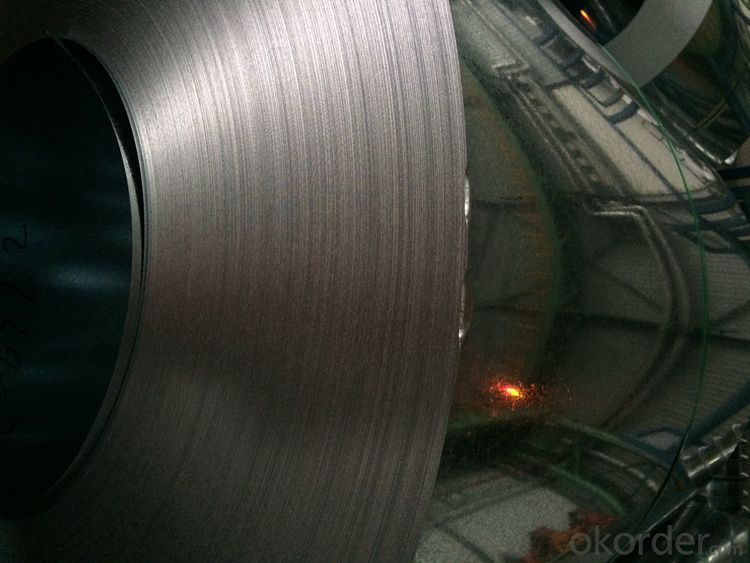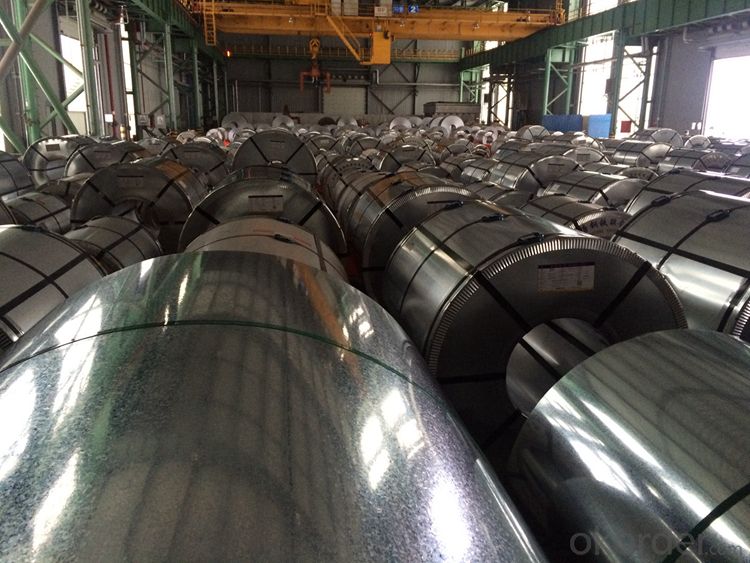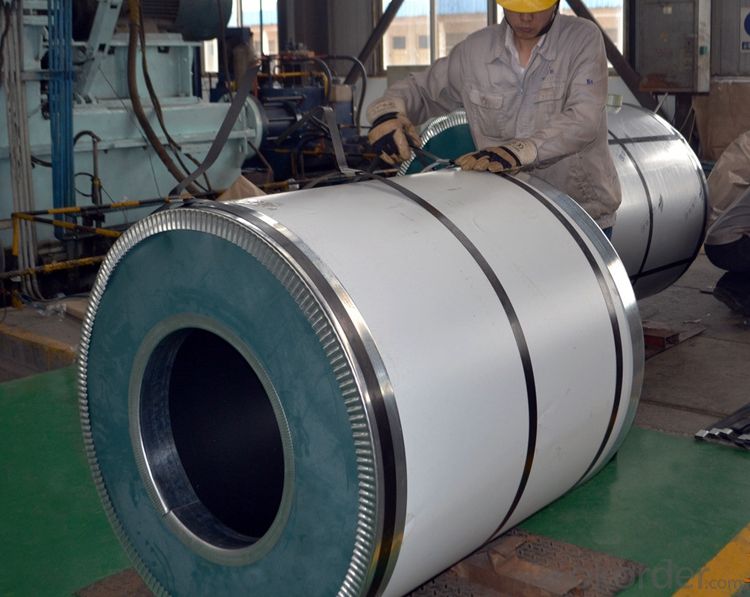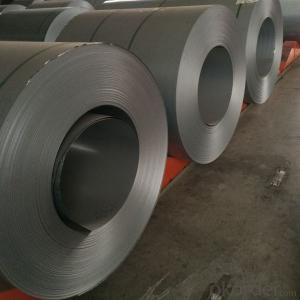High Quality DX51D Galvanized Steel Coil Regular Spangle Competitive Price
- Loading Port:
- Tianjin
- Payment Terms:
- TT OR LC
- Min Order Qty:
- 50 m.t.
- Supply Capability:
- 100000 m.t./month
OKorder Service Pledge
OKorder Financial Service
You Might Also Like
Item specifice
DESCRIPTION FOR GALVANIZED STEEL COILS:
1) Size: 0.30-2.0mm x 1,000-1,500mm x C
2) Zinc coating: 80-275g/m2;
3) Spangle: regular, zero and minimized
4) Material: we can supply different qualities according to several standards,
such as:
a) SGCC, SGCD, SGCE according to JIS G3302
b) DX51D+Z, DX52D+Z, DX53D+Z, DX54D+Z to EN 10142
EXPORT STANDARD FOR GALVANIZED STEEL COILS:
-Axial and circumferential steel straps with seal (4 steel straps each)
-VCI Anti-rust kraft paper
-Water-proofing plastic
-Pearl wool (coil surface)
-Steel cover (coil surface/bore)
-Plastic cover (coil sides)
-Inside and outside corner protectors
Or According customers' requirements(Usually only for domestic)
RAW MATERIALS FOR GALVANIZED STEEL COILS:
(1)Hot dipped galvanized steel sheet
(2)color coated galvanized steel sheet
(3)Galvalume steel sheet
(4)Prepainted galvalume steel sheet
(5)Aluminum sheet
(6) Prepainted aluminum sheet
(7)Stainless steel sheet
PACKAGING &DELIVERY FOR GALVANIZED STEEL COILS:
Packaging Detail Standard export packing or following customer's demand
Delivery Time: Within 30-40 days after deposit or according to the order quantity
TRADE TERMS FOR GALVANIZED STEEL COILS:FOB, CFR, CIF
DETAILED PICTURES FOR GALVANIZED STEEL COILS:



APPLICATION FOR GALVANIZED STEEL COILS:
Guardrails, ventilation ducts, gutters and down spouts, Pre-paint and post paint applications, gutters and ceiling suspension bars, shutter door rails. Auto parts, electrical appliances, refrigerator appliances, signs, automotive parts,vending machines, washing machines, showcases and other structural use, roofing, commercial use.
FAQ FOR GALVANIZED STEEL COILS:
Q:How about the delivery time?
A:Within 15-30days after receiving the deposit or L/C at sight.
FAQ FOR GALVANIZED STEEL COILS:
Q:How about the trade terms?
A:EXW,FOB,CFR,CIF will be accepted.
- Q:What are the different methods of coil recoiling for narrow strip widths?
- There exists a variety of techniques for coil recoiling targeted at narrow strip widths. One technique, known as slitting and recoiling, entails slicing the wide coil into narrower strips and then rewinding them onto a smaller coil. This is typically accomplished using a slitting machine, which can make precise cuts to achieve the desired strip widths. Another approach, referred to as edge trimming and recoiling, involves trimming the edges of the wide coil to generate narrower strips. The remaining material is then rewound onto a smaller coil. This method is commonly employed when the coil edges are damaged or uneven and need to be removed before recoiling. Furthermore, there is a method called tension recoiling. In this process, the wide coil is threaded through a series of tensioning devices that aid in achieving the desired strip widths. The tensioning devices can apply controlled pressure to the coil edges, enabling precise recoiling of narrow strips. Additionally, some companies opt to employ laser cutting technology for coil recoiling. This technique entails using a laser beam to slice the wide coil into narrow strips, which are then rewound onto a smaller coil. Laser cutting offers exceptional precision and accuracy, making it an ideal choice for narrow strip widths. In summary, the various methods of coil recoiling for narrow strip widths consist of slitting and recoiling, edge trimming and recoiling, tension recoiling, and laser cutting. Each approach possesses its own merits and is selected based on the specific requirements and capabilities of the manufacturing process.
- Q:the comparison needed between other steel
- It's cheaper than alloyed steels.
- Q:What are the dimensions of steel coils used in automotive component manufacturing?
- The dimensions of steel coils used in automotive component manufacturing vary depending on the specific application and requirements. However, common dimensions include thicknesses ranging from 0.5mm to 3mm and widths ranging from 600mm to 2000mm.
- Q:I am making a sword of 1060 carbon steel and would like to know how to heat treat it once it's ready, could anyone help please?
- Heat treating easy, HA! It is the most critical part of bladesmithing. Done wrong and all those hours of work go up in smoke (or a snap of the steel). You'll need a bucket of oil, preferably one that is deep enough to go in point first. If not you'll have to go in edge first, not recommended on a double edged blade, ok for single edge. You'll need to build a charcoal fire long enough for the blade. You will need to blow air under the fire to get it hot enough, the challenge is getting the heat even. You get the fire going and established, put the blade in turning it back and forth (if you keep turning it in the same direction when it heats up you could work a twist in it). When it starts turning red pull it out and touch it with a magnet, if the magnet sticks put it back. Keep heating and repeating until the magnet no longer sticks. Heat a little more, then quench rapidly point first. Don't let the blade lean to one side as warpage will occur. When it cools enough to touch, check with a file. If the doesn't file cut then you've properly hardened the steel and it's ready for temper. Now comes the really hard part. Grind the scale off carefully,preferably with a side grinder with a flap wheel. I've had hard wheel break freshly hardened blades. After cleaning you'll need to put it in an oven (preferred) or use a torch and carefully heat the blade. Watch the temper colors (oven temp 500-550F) or with the torch as the steel turns colors blue to purple for a double edged weapon. Any warpage that occurs needs to be worked out at temping temp.
- Q:The stainless steel drinking fountain had a little acid on it and rusted. I need to restore it. Is this possible?
- Stainless steel doesn't rust, whatever acid you got on it was some pretty bad stuff to make a reaction like that, you can try sanding down past the reaction point and polish it out but that's about it, that or it wasn't stainless to begin with. if its brushed chrome to simulate stainless it would have to be replated, not cheap. and probably not worth it
- Q:I'm searching for the elastic modulus of ASTM A653 galvanized steel sheet. Max points for first person with a response that includes web address of reliable reference - I just haven't found it yet. thanks!
- Aluminum is non ferrous so a magnet won't persist with it, and this is softer than steel. once you have desperate that, if it has previous paint on it, this is particularly helpful to apply a primer that corresponds to the paint you would be utilising the two vinyl or oil based, then paint. this is possibly no longer Galvanized, yet whilst this is, the unpainted floor with have a 2 colour steel Spackle look.
- Q:What is the maximum stacking height for steel coils?
- The maximum stacking height for steel coils depends on various factors such as the size and weight of the coils, as well as the strength and stability of the storage facility. Generally, it is recommended to stack steel coils up to a height of 3 to 5 coils, ensuring proper weight distribution and stability to prevent damage or accidents.
- Q:How are steel coils used in the manufacturing of building materials?
- Steel coils are widely used in the manufacturing of building materials due to their strength, durability, and versatility. These coils are typically made from high-quality steel and are shaped into a continuous, flat strip. One of the most common uses of steel coils in building materials is for the production of steel roofing and siding. The coils are processed through a series of machines that cut, shape, and roll the steel into the desired dimensions and profiles. The resulting roofing and siding materials are then used to construct durable and weather-resistant building envelopes. Steel coils are also used in the manufacturing of steel studs, which are essential components for framing structures. The coils are cut and formed into precise shapes, then assembled to create a strong and rigid framework for walls, ceilings, and other structural elements. Steel studs offer numerous advantages such as high strength-to-weight ratio, fire resistance, and dimensional stability, making them a popular choice in the construction industry. In addition to roofing, siding, and framing, steel coils are utilized in the production of various other building materials. These include steel pipes, beams, columns, and reinforcement bars, which are used in the construction of foundations, infrastructure, and structural elements. Steel coils also serve as raw materials for the fabrication of metal panels, doors, windows, and other architectural components. Overall, steel coils play a crucial role in the manufacturing of building materials as they provide the necessary strength and durability required for long-lasting and robust structures. Their versatility allows for the production of a wide range of building components, making steel coils an indispensable resource in the construction industry.
- Q:What are the different methods of punching steel coils?
- For punching steel coils, there are several methods available that vary depending on specific requirements and desired outcomes. The following are some commonly used methods: 1. Mechanical Punching: To create holes in the steel coil, a mechanical press is employed. This method involves utilizing a punch and die set, where the coil is subjected to force from the punch to create the hole. Mechanical punching is best suited for small to medium-sized holes and finds frequent use in high-volume production settings. 2. Hydraulic Punching: In hydraulic punching, hydraulic pressure is utilized to drive the punch into the steel coil. This method is commonly employed for punching larger holes or shapes that demand greater force. Hydraulic punching machines offer precise control and can handle thicker and harder materials. 3. Laser Cutting: Laser cutting is a non-contact technique that employs a laser beam to cut through the steel coil. By directing a focused laser beam onto the coil, the material is melted and evaporated to form the desired shape or hole. Laser cutting provides high precision and can be used for complex shapes and patterns. 4. Plasma Cutting: Plasma cutting involves the use of a high-velocity jet of ionized gas (plasma) to melt and remove the steel coil material. This method is suitable for cutting thicker steel coils and is often employed for larger holes or irregular shapes. 5. Waterjet Cutting: Waterjet cutting uses a high-pressure jet of water mixed with abrasive particles to cut through the steel coil. This method is versatile and can effectively cut various materials, including steel. Waterjet cutting is renowned for its high precision and clean cuts. Each method of punching steel coils possesses its own advantages and considerations. Factors such as material thickness, desired precision, production volume, and cost will determine the most suitable method for a specific application.
- Q:What is the shear modulus of steel and silver? Please help! and state where you got it from...what site did you used? Thanks.
- Shear Modulus Of Steel
1. Manufacturer Overview |
|
|---|---|
| Location | |
| Year Established | |
| Annual Output Value | |
| Main Markets | |
| Company Certifications | |
2. Manufacturer Certificates |
|
|---|---|
| a) Certification Name | |
| Range | |
| Reference | |
| Validity Period | |
3. Manufacturer Capability |
|
|---|---|
| a)Trade Capacity | |
| Nearest Port | |
| Export Percentage | |
| No.of Employees in Trade Department | |
| Language Spoken: | |
| b)Factory Information | |
| Factory Size: | |
| No. of Production Lines | |
| Contract Manufacturing | |
| Product Price Range | |
Send your message to us
High Quality DX51D Galvanized Steel Coil Regular Spangle Competitive Price
- Loading Port:
- Tianjin
- Payment Terms:
- TT OR LC
- Min Order Qty:
- 50 m.t.
- Supply Capability:
- 100000 m.t./month
OKorder Service Pledge
OKorder Financial Service
Similar products
New products
Hot products
Related keywords






























